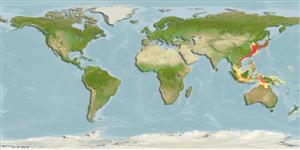Environment: milieu / climate zone / depth range / distribution range
Ekologi
laut; air tawar; payau dasar (demersal). Subtropical
Northwest Pacific.
Size / Weight / umur
Maturity: Lm ? range ? - ? cm
Max length : 20.4 cm TL jantan/; (Ref. 112063); Berat maksimum terpublikasi: 33.90 g (Ref. 112063)
Inhabits shallow sandy bottoms of bays (Ref. 43239).
Life cycle and mating behavior
Kematangan | Reproduksi, perkembang biakan | Pemijahan | telur-telur | Fecundity | Larva
Wu, H.-L., 1991. Callionymoidei. p. 417-422. In J.-H. Pan, L. Zhong, C.-Y. Zheng, H.-L. Wu and J.-H. Liu (eds). 1991. The freshwater fishes of Guangdong Province. Guangdong Science and Technology Press, Guangzhou. 589 pp. (Ref. 33468)
Status IUCN Red List (Ref. 130435: Version 2024-1)
ancaman kepada manusia
Harmless
penggunaan manusia
Alat, peralatan
laporan khas
muat turun XML
Sumber internet
Estimates based on models
Preferred temperature (Ref.
123201): 15.2 - 27, mean 21.8 °C (based on 199 cells).
Phylogenetic diversity index (Ref.
82804): PD
50 = 0.5000 [Uniqueness, from 0.5 = low to 2.0 = high].
Bayesian length-weight: a=0.00794 (0.00471 - 0.01341), b=2.73 (2.59 - 2.87), in cm total length, based on LWR estimates for this species & Genus-body shape (Ref.
93245).
Trophic level (Ref.
69278): 3.2 ±0.40 se; based on food items.
Daya lenting (Ref.
120179): sedang, Waktu penggandaan populasi minimum 1.4 - 4.4 tahun (Preliminary K or Fecundity.).
Fishing Vulnerability (Ref.
59153): Low vulnerability (10 of 100).
